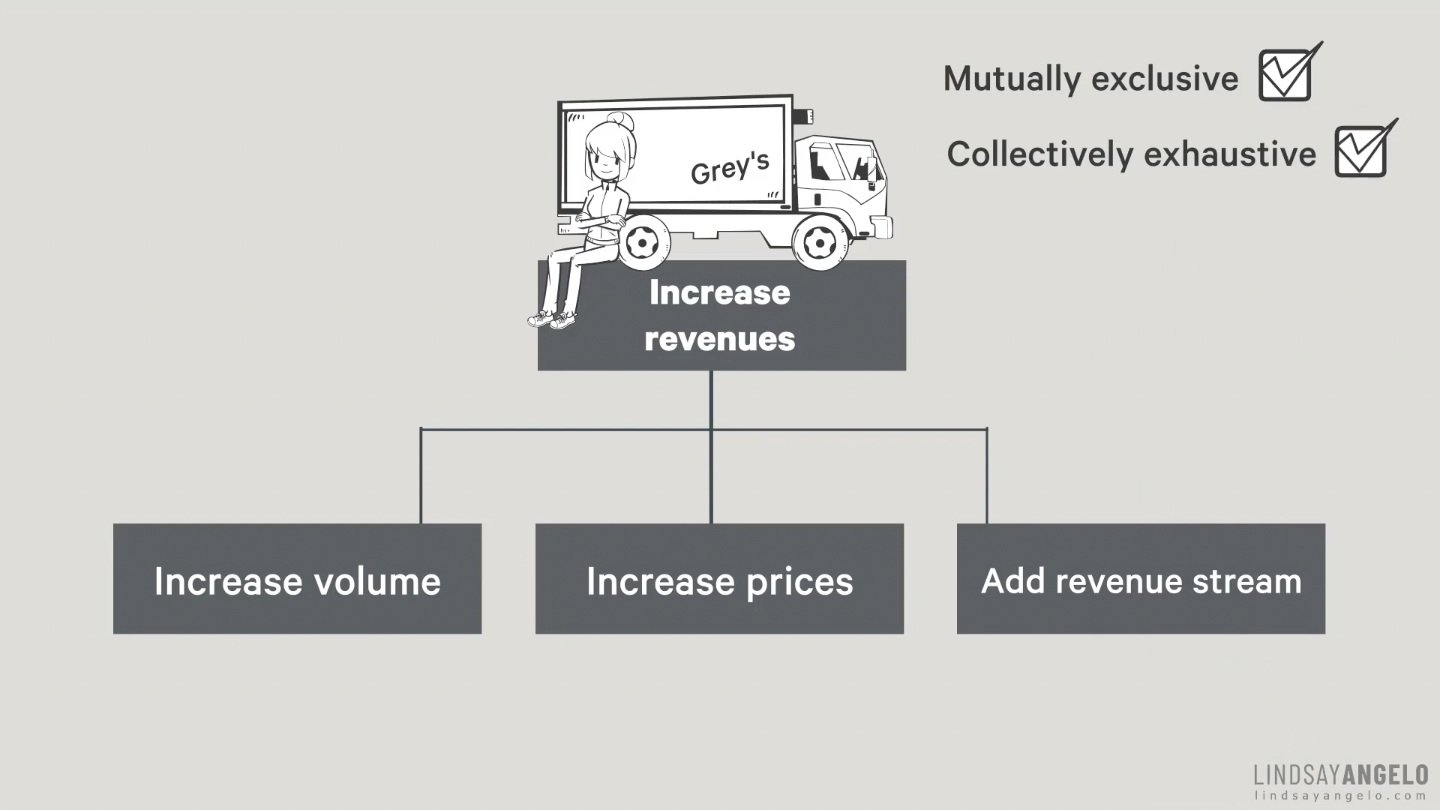Table of Contents
Introduction
What is MECE and Why Should You Use It?
When Should You Use MECE?
How to Use MECE?
Examples of MECE in Action
Common Applications of MECE
Stress Testing Your MECE Framework
FAQs
Key Takeaways
MECE helps break down complex problems efficiently and effectively – by using a structured, rigourous and effective methodology
A logic tree is the best way to apply MECE – visualizing a problem through a structured tree diagram ensures no critical factors are overlooked and that thinking remains organized.
Avoid overlap and gaps in categorization – a truly MECE breakdown prevents duplication while ensuring completeness, leading to sharper insights and better decisions.
MECE is applicable across various industries and situations – whether segmenting markets, analyzing revenue streams, or making strategic decisions, MECE is a versatile tool for professionals.
Introduction
If you're like most business professionals, you want to be able to solve key issues quickly and efficiently. But how can you effectively do that without a framework to lean on? Enter “MECE”... a problem-solving framework that helps you organize your thoughts and analyze information quicker and more effectively. A key concept and tool of choice in many a consultant's arsenal, MECE is a central pillar of effective problem-solving. In this blog post, we will discuss what MECE is, why it is a valuable tool, and how to maximize your problem-solving and strategic thinking using the tool.
What is MECE and why should you use it?
MECE is an acronym that stands for "mutually exclusive, collectively exhaustive." It's a problem-solving framework that was popularized by consulting firm, McKinsey & Company. We use MECE because it forces you to look carefully at each part of the problem and all parts of the problem which leads to a deeper understanding of the problem space and often, compelling insights. When working on a project, the MECE framework is a method to organize your thoughts and information so that you can quickly identify and solve problems. MECE forms the basis for hypothesis-driven thinking, which you can learn more about here.
When should you use MECE?
MECE is most effective when you're working on complex problems with many moving parts, a tight timeline, and requiring a lot of fact-finding or information analysis. That said, the MECE principle can be used for virtually any type of problem-solving. Whether trying to solve real-life problems such as deciding what to have for dinner, or figuring out which market segments to enter, MECE will serve as a powerful framework.
How to use MECE?
MECE comes to life visually as a logic tree. What is a logic tree? A logic tree is a diagram that helps you to understand and organize complex problems or issues. It's essentially an upside-down tree that shows the relationships between different variables in a problem and in doing so, helps to ensure you've thought through the entirety of the problem and all of its parts.
Examples of MECE
Let's see MECE in action. Grey is an entrepreneur who owns a food truck that serves her local market. She is attempting to increase revenues. So, how can she increase revenues? To apply MECE to this problem, we would include the problem statement, "increase revenues" at the top of the tree. From there, we'd ask "what needs to be true for the statement "increase revenues" to be true?". Or in other words, how can Grey increase revenues?
Well, she could:
a) increase volume,
b) increase prices and,
c) add a revenue stream
These three solutions inform the second layer of the MECE tree, as shown in the diagram to the right. Notice that these three categories cover all the revenue drivers (collectively exhaustive) without overlapping one another (mutually exclusive).
On the flip side, what's an example of non-MECE groupings? If the segmentation included a fourth category titled "add a new dish", this would be non-MECE because adding a new dish overlaps with "add revenue stream" - in other words, those groupings are not mutually exclusive.
Other common examples of MECE groupings or the MECE principle applied include:
segmenting the population into age groups where each group is distinct from another and all the groups are included.
market sizing exercises whereby a market is broken down into its distinct components with no overlap
identifying category drivers of revenue, whereby all are distinct from one another and exhaustive, capturing all of the components of revenue
The bottom line? MECE is a powerful problem-solving framework that's key to any business leader's toolbox. It allows you to organize your thoughts and information so that you can quickly identify and solve complex issues/complex ideas, arrive at meaningful insights, and tackle your problem with confidence. Give it a try the next time you're stuck on a problem! You might be surprised at how quickly a solution will reveal itself.
Stress test your MECE framework
Once you arrive at a draft of your MECE tree, you'll want to "stress test" it to ensure you're covering all the bases and have maintained the integrity of the problem. Leverage your teammates and peers for this! Working collaboratively with a diverse group will produce a much higher quality MECE tree.
Looking for MECE consulting or for help in applying the MECE framework? Contact Lindsay Angelo, renowned strategy consultant for one-on-one consulting. You can also learn more through reading “The MECE Muse”.
Read more about issues trees, MECE principle, the pyramid principle, hypothesis driven thinking, strategic thinking, strategic thinking exercises, and futures thinking.
FAQs
-
A MECE framework/analysis is a tool that can be used to help you organize and analyze information. It is often used by management consulting firms in the consulting process to help people make decisions. The acronym "MECE" stands for "mutually exclusive and collectively exhaustive." This means that the categories in a MECE analysis are mutually exclusive (they do not overlap) and that they are collectively exhaustive (they cover all possible options). These are the basic components of the MECE framework. Using a MECE framework can help you to avoid making mistakes when making critical business decisions.
-
One common example is when companies use MECE to create product lines. By creating products that are mutually exclusive and collectively exhaustive, companies can ensure that they have a product for every customer's need. For example, a company creates product A that attaches to your sink to save water while washing food off of dishes. Product B is an attachment to your water hose to save water while watering your lawn. Both products are offering consumers a way to save water but both products cannot act synonymously. Another popular example is dividing a segmentation by the ages of customers. Imagine you have 10-14 people in a group and you are told to divide them into 2 groups. Group one is people aged 1-50 and the other group is people who are ages 51-100. Common mistakes people will make is making the second group 50-100 which is not mutually exclusive, which is NOT MECE! This approach can also be used to segment markets or target specific age segments.
-
There are a few steps to creating your own MECE framework. First, identify the main components of your issue or problem. Second, break down those components into smaller, more manageable pieces. And third, organize those pieces in a way that follows the core principle of mutually exclusive, collectively exhaustive. You can do this by making sure there is no overlap between parts. Once you have the basic structure of your MECE framework in place, you can start filling in the details. This is where you'll want to think about what goes into each component and how it all fits together. A MECE framework forms the basis of a variety of logic trees (hypothesis trees/solution trees and issue trees).
-
Here are a few tactics that management consultants use to generate MECE frameworks:
Ensure you are being mutually exclusive and collectively exhaustive. This is the backbone of creating a strong MECE framework. Mutual exclusivity allows for a clean delineation of the problem's parts and exhaustive categories or an exhaustive list enables you to think through all of the components.
Check that you are focusing on the most important ideas within the problem you are trying to solve. You want to make sure that you are including these.
Collaborate with others in crafting your MECE tree and leveraging a MECE framework. Whether you're focused on a problem/issue or solution, introducing fresh thinking will only help.
-
No, although there are some similarities, MECE is different from a decision tree, decision tree approach, or decision tree technique.
-
Yes, management consulting firms across the globe, including McKinsey & Co, BCG, Bain, etc. all use MECE. In fact, MECE is often included in consulting case interviews and consulting interviews in general. MECE consulting is common practice amongst big consulting firms.
-
A non-MECE framework or non-MECE segmentation is where the components either overlap, do not exhaust the relevant field, or a combination of both.
-
The original concept was invented by Aristotle, but Barbara Minto, who worked at McKinsey, is credited for creating the abbreviation and applying it to analyzing groups of ideas.
-
Enroll in Lindsay’s Strategic Thinking Masterclass here. Click here to read an article about MECE principle. Or here for more examples of what MECE is.
About the Author
Lindsay provides growth strategy services to purpose-driven brands, including MECE consulting, leveraging MECE as core problem-solving tool and problem-solving process. Named a global innovation leader and Women to Watch, you will find her at the intersection of strategy, story-telling, and innovation. When she’s not collaborating with clients, she’s hitting TEDx and other stages across North America to deliver keynotes on the future of consumerism, strategy, and innovation. Prior to advising and providing brand and marketing consulting services, Lindsay spent six years at lululemon crafting their global growth strategy, exploring new marketplace opportunities, and growing the company into the number one yoga wear player in the world. Her experiences culminate in what she refers to as her sweet spot - where strategy, innovation, and insights intersect, where the rational meets the emotive, where facts meet insights, and where logic meets creativity.




